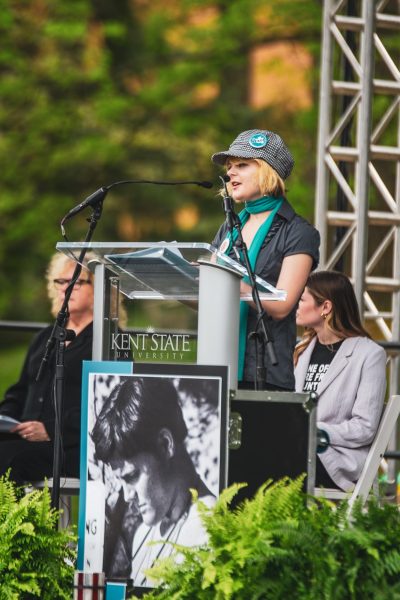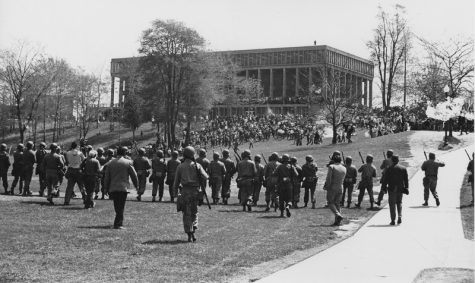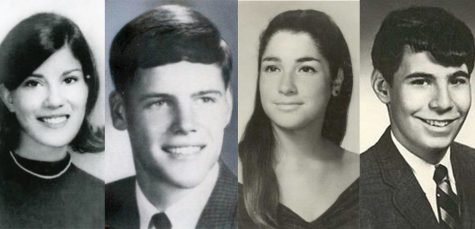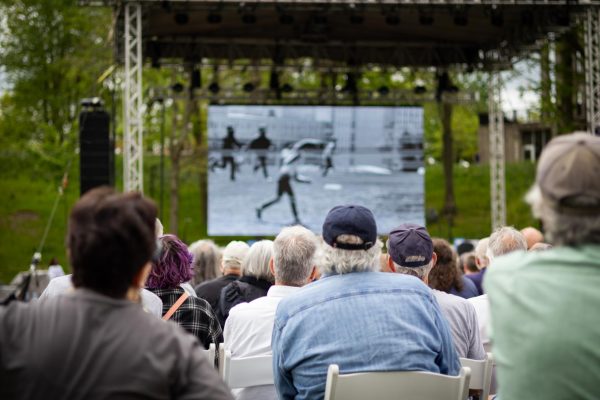As the commemoration of May 4 draws near, Kent State students and community members are looking for different ways to remember the tragedy and spark conversations.
This will mark 55 years since the Ohio National Guard fired into a crowd of students demonstrating against the Vietnam War on campus in 1970, killing four and wounding nine.
Now, decades later, the university community will come together once again for a series of events to honor the victims and their families and reflect on what occurred on the day that changed Kent State forever. The May 4 Task Force, the student-led organization focused on preserving the memory of May 4, is planning several gatherings on campus that aim to get students involved and learn about this period of the university’s history.
“We really want to promote that legacy of freedom of speech, the First Amendment, sticking up for one’s grievances and questioning authority,” Sophia Swengel, a senior history major and president of the May 4 Task Force, said.
The campus-wide events scheduled to take place leading up to and on May 4 include a banner-painting activity on the K, the candlelight vigil on May 3 and the May 4 commemoration at noon on the Commons. Students, administrators and survivors will deliver speeches followed by the ringing of the Victory Bell and a moment of silence at 12:24 p.m.
As Kent State prepares to mark the anniversary, Swengel said spaces like the May 4 Visitors Center and the gallery serve as important ways to honor the legacy of activism that fueled May 4.
“We have a lot that connects activism to art and creative expression,” Swengel said.

One of the bigger themes of the task force this semester, Swengel said, is encapsulated by the quote “Flowers are better than censorship,” a play on words inspired by Rodney Dillman’s novel on May 4, “Flowers Are Better Than Bullets.” Allison Krause, a student who was killed on May 4, echoed this phrase to Ohio National Guardsmen on campus the day before her death, according to her sister Laurel Krause.
Her words were said to have been an effort toward promoting peace and an end to war, and after all these years, Swengel said it’s crucial to remember the efforts of Krause and the other students who lost their lives on May 4, 1970.
13 seconds that shook Kent State
The invasion of the United States into Cambodia in late April of 1970, which quickly escalated the war in Vietnam, spurred many college students across the country, including at Kent State, to voice their opposition.
As peaceful protests started on campus the afternoon of May 1, students gave energized speeches while striking against the Nixon administration and buried a copy of the Constitution, symbolizing its death. That night, however, the situation became more violent as protesters clashed with local police downtown. While the exact causes for what happened are still unknown, bonfires were built in the streets and some windows of stores and businesses were broken.
Following this, LeRoy Satrom, the mayor of Kent at the time, declared a state of emergency, and the Ohio National Guard was called in the following day, making the campus appear to be a war zone.
Confrontations on Sunday, May 3 led to rocks being thrown, arrests made and tear gas used on students.
Then, on May 4, approximately 3,000 people occupied the Kent State Commons, with around 500 demonstrators gathered around the Victory Bell.
On this day, protestors did not just gather to express outrage over the Vietnam War, but more so to protest the occupation of the National Guard on campus.
Before noon, General Robert Canterbury ordered the demonstrators to disperse, but he was met with defiance. Several minutes later, rocks were thrown as students shouted back at the guards, and Canterbury ordered his men to load their weapons.

Tear gas was fired by the Liberty Bell, forcing the crowd to run up Blanket Hill and down the other side to the Prentice Hall parking lot, which was near the practice football field. Surrounded by a fence and feeling trapped, students hurled rocks through the air at the guards as the shouting grew louder.
Then, 28 guardsmen abruptly turned and fired between 61 and 67 shots within 13 seconds into the air, ground and crowd.
Jeffrey Miller, who was closest to the guards, was shot in the mouth and killed while standing close to the parking lot.
Allison Krause, who was also in the parking lot, was shot in the chest and killed.
William Schroeder, also in the lot, was shot in the back and died.
Sandra Scheuer was shot in the left front side of her neck while she was just walking to class.
All of the students killed were between the ages of 19 and 20 years old.
After this tragedy occurred, none of the guardsmen were criminally charged.

Carol Dawson, an Ohio resident, said her husband was a member of the Kent State Police during the events of May 4, and she recalls him spending a long time on campus helping contain the demonstrations.
“He was not able to come back home for at least a week, as the Kent State Police had to stay on campus,” Dawson said.
Dawson said she remembers her husband saying the National Guard’s presence on campus seemed to escalate tensions around the time of May 4.
“As a police officer for the university, he never felt that the National Guard should have been called in,” Dawson said. “It just heightened the students. They also felt that outsiders had really gotten the students to riot.”
While some still believe outside influencers were responsible for the violence that occurred downtown and on campus in the events leading up to May 4, many of the answers to these questions still remain unknown.
Looking forward

As the 55th anniversary of May 4, 1970, approaches, Swengel said it’s critical for students and the Kent community to join together, remember the students who lost their lives more than five decades ago and continue advocating for free speech and student voices.
“There is a lot of really cool history [Kent State students] are upholding, and that is a really unique position to be in — to carry that legacy on and honor those lives that we lost,” Swengel said.
For more information about this year’s commemoration events and what to expect, students and community members can visit the May 4 page on Kent State’s website.
Tanner Smith is a beat reporter. Contact him at [email protected].



David B. • Apr 26, 2025 at 12:05 pm
Tear gas was fired by the Liberty Bell → Tear gas was fired by the Victory Bell
David B. • Apr 26, 2025 at 12:05 pm
to protest the occupation of the National Guard on campus →
to protest the occupation of the campus by the National Guard
David B. • Apr 26, 2025 at 11:47 am
planning several gatherings on campus that aim to get students involved and learn about this period →
planning several gatherings on campus that aim to get students involved and help them learn more about this period